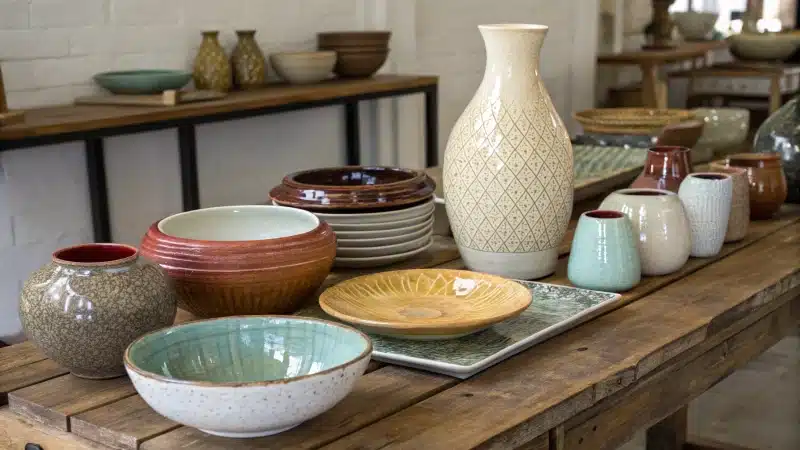
Choosing a ceramic supplier isn’t just business; it’s about finding the right partner for your vision.
To choose the best ceramic suppliers for your business, consider product quality, customization options, pricing, compliance with international standards, and reliable support services. Ensure they offer eco-friendly products and can adapt to design trends for a successful long-term partnership.
I remember when I first ventured into the ceramics world. It was exciting yet overwhelming, with so many choices and possibilities. But it taught me that the right supplier is more than just a source; they’re a collaborator who understands your brand’s heart. By focusing on these factors, you not only ensure quality but build a partnership that grows alongside your business dreams. Let’s explore what makes a ceramic supplier truly exceptional and how you can find the perfect match.
Product quality is the most critical factor in choosing suppliers.True
Quality ensures durability and customer satisfaction, impacting business success.
Ceramic suppliers must offer only eco-friendly products.False
While beneficial, not all businesses prioritize eco-friendly products.
What Are the Key Quality Indicators in Ceramic Products?
I remember the first time I walked into a ceramics shop, mesmerized by the delicate blend of form and function. But what truly defines quality in these beautiful creations?
The key quality indicators in ceramic products include material composition, surface finish, structural integrity, thermal resistance, and compliance with safety standards. These factors ensure durability, aesthetic appeal, and functionality.

Material Composition
Diving into ceramics, I’ve realized that the soul of a quality piece lies in its material composition1. Once, I visited a factory where a craftsman shared how the blend of refined clay and kaolin made all the difference. Watching him work was like witnessing art in motion; each mix was chosen to enhance both durability and elegance.
Surface Finish
There’s something magical about running your fingers over a smooth ceramic surface. I remember feeling a glazed plate at a pottery exhibit and thinking how its sheen seemed almost like a glassy lake. A high-quality finish should be perfect, free from cracks or bubbles, ensuring it not only looks good but performs well.
Structural Integrity
Every ceramic item I’ve ever picked up tells a story of its resilience. I recall testing a dinnerware set for impact resistance, marveling at how it survived without a scratch. This testing ensures that whether you’re microwaving leftovers or serving a hot meal, your ceramics remain steadfast.
| Test Type | Purpose |
|---|---|
| Impact Resistance | Ensures product can withstand external forces |
| Thermal Shock | Tests ability to handle temperature changes |
| Load Bearing | Assesses strength under weight |
Thermal Resistance
One winter evening, while cooking with ceramic pots, I appreciated their ability to endure high temperatures. It’s this thermal resistance that’s crucial, ensuring that even my grandmother’s slow-cooked recipes come out perfectly without compromising the pot’s structure or finish.
Compliance with Safety Standards
Safety is non-negotiable in my book. I vividly remember the relief of knowing my favorite mug was certified free of harmful substances like lead. Certifications2 offer peace of mind that these items are safe for everyday use, especially in the kitchen.
Understanding these indicators has become second nature to me. Whether you’re crafting ceramics or selecting pieces for your home, focusing on these elements ensures you’re choosing items that are not only functional but also enduringly beautiful.
Porcelain contains high kaolin content for translucence.True
Porcelain's translucence and strength come from its high kaolin content.
Ceramics with bubbles in glaze have superior quality.False
Bubbles in the glaze indicate imperfections, lowering ceramic quality.
How Do Customization Capabilities Impact Your Choice of Supplier?
Imagine you’re on a quest for the perfect supplier, and customization is the compass guiding your way.
Customization capabilities significantly impact supplier choice by enabling businesses to meet specific needs and market demands. They offer flexibility in product design, enhance brand identity, and facilitate competitive differentiation, making them crucial for strategic supplier selection.

The Role of Customization in Product Design
In my journey of crafting unique ceramic pieces, I’ve realized how vital customization is in product design. Imagine walking into a shop and seeing a mug that feels like it was made just for you—that’s the power of customization. It allows businesses like mine to tailor products precisely to their specifications, enhancing their brand identity3. This flexibility is particularly vital in industries like ceramics, where unique designs can set a brand apart. Suppliers offering robust customization options enable companies to innovate without constraints.
| Benefit | Description |
|---|---|
| Flexibility | Adapt designs to fit specific requirements |
| Enhanced Brand Identity | Unique products reflect company values |
| Innovation | Allows creative exploration |
Enhancing Competitive Differentiation
Standing out in a crowded market is no small feat. I remember when my business first started, we had to find ways to make our ceramic mugs catch the eye of potential customers. Customization capabilities are like that secret ingredient that allows businesses to offer products competitors can’t. This competitive edge4 can lead to increased market share and customer loyalty. Suppliers adept at customization provide the tools necessary to carve out unique market positions.
Addressing Market Demands with Agility
In the fast-paced world we live in, responding quickly to changing market demands is crucial. I’ve seen firsthand how agility can make or break a business. Suppliers with strong customization capabilities can rapidly produce tailored products, allowing businesses to respond agilely5 to consumer trends and preferences. This agility is essential for maintaining relevance in fast-paced industries.
- Speed: Quick adaptation to trends
- Relevance: Meets evolving consumer needs
- Sustainability: Reduces waste by avoiding mass production
Strategic Supplier Selection
When it comes to choosing a supplier, it’s like finding a partner who truly gets your vision. You want someone who’s not only technologically savvy but also committed to innovation. Selecting a supplier with advanced customization capabilities involves assessing their technological prowess6 and commitment to innovation. Businesses must evaluate how well a supplier’s customization options align with their strategic goals, ensuring a partnership that fosters growth and adaptability.
- Technology: Invested in modern solutions
- Innovation: Continually developing new processes
- Alignment: Matches business objectives
Customization enhances brand identity.True
Customization allows products to reflect a company's unique values.
Suppliers with customization are less agile.False
Customization enables quick adaptation to changing market demands.
Why Is Pricing and Lead Time Important in Supplier Selection?
Ever had a perfect mug idea but couldn’t find the right partner to bring it to life? I’ve been there, and here’s why choosing the right supplier matters.
Pricing and lead time are essential in supplier selection because they impact a company’s bottom line and ability to meet customer demands. Proper evaluation helps businesses maintain cost efficiency and reliability.

Understanding the Role of Pricing
In my journey with MTCeramic, I’ve realized that pricing isn’t just about picking the cheapest option. It’s like choosing between a fast food joint and a gourmet restaurant; each offers different value beyond just cost. I’ve often found that a supplier with a slightly higher price tag can actually save me money in the long run by providing superior quality or terms that suit my business better.
Evaluating Lead Time’s Impact
Lead time is like the heartbeat of my business operations. The quicker a supplier can deliver without compromising quality, the better I can serve my customers. I remember a time when delayed shipments caused us to miss out on a significant trend, leaving me with unsold inventory. That experience taught me the importance of partnering with suppliers who have proven track records of prompt delivery.
Balancing Pricing and Lead Time
Finding the right balance between pricing and lead time feels like piecing together a puzzle. I use a supplier scorecard7 to weigh these factors along with others like quality and service. For instance, when comparing suppliers, I look at tables like this:
| Criteria | Supplier A | Supplier B | Supplier C |
|---|---|---|---|
| Pricing | $$ | $$$ | $ |
| Lead Time | 2 weeks | 4 weeks | 1 week |
| Quality Rating | High | Medium | Low |
This visual aid helps me navigate trade-offs and make informed decisions that align with my business priorities.
Strategic Considerations
Beyond immediate logistics, I’ve learned that nurturing strategic relationships with suppliers is invaluable. Having open dialogues about flexible payment options8 or volume discounts often leads to mutually beneficial agreements. I’ve seen how strong partnerships can spark innovation, whether it’s in developing new product lines or adopting sustainable practices. Keeping communication lines open ensures both parties thrive.
Pricing reflects supplier quality and market position.True
Pricing indicates a supplier's quality, capability, and market position.
Shorter lead times decrease inventory efficiency.False
Shorter lead times actually increase inventory efficiency.
How Can Strong Communication Enhance Supplier Partnerships?
Ever wondered how a simple conversation can turn into a business game-changer?
Strong communication enhances supplier partnerships by ensuring clarity, fostering trust, and enabling proactive problem-solving. It supports seamless collaboration, aligns goals, and facilitates efficient decision-making, ultimately strengthening the business relationship.

The Role of Clarity in Communication
Clear communication minimizes misunderstandings and sets the foundation for effective collaboration. When expectations, timelines, and deliverables are clearly outlined, both parties can avoid confusion9 and work toward shared objectives. This clarity enables suppliers to understand client requirements, leading to better product quality and timely delivery.
Trust: The Core of Supplier Relationships
Building trust is essential for successful partnerships. Open and honest communication fosters trust, encouraging suppliers to share valuable insights and feedback. When businesses actively listen and respond to supplier concerns, they demonstrate reliability, creating a supportive environment for growth.
- Open Dialogue: Encourages transparency, essential for addressing challenges early.
- Feedback Mechanisms: Strengthen relationships by showing commitment to continuous improvement.
| Communication Strategy | Benefits |
|---|---|
| Regular Updates | Keeps all parties informed and engaged |
| Active Listening | Demonstrates respect and understanding |
Proactive Problem-Solving
Strong communication enables proactive problem-solving by allowing partners to address potential issues before they escalate. By maintaining an open line of communication, businesses can work collaboratively with suppliers to identify risks and develop contingency plans. This approach not only mitigates disruptions but also builds resilience within the supply chain.
- Regular Check-ins: Facilitate ongoing dialogue and immediate resolution of concerns.
- Joint Planning Sessions: Encourage alignment on strategic initiatives.
Aligning Goals for Mutual Success
Effective communication helps align business objectives with supplier capabilities. By discussing long-term goals and market trends, partners can create strategies that leverage each other’s strengths. This alignment fosters a sense of mutual investment in each other’s success.
Consider setting up collaborative platforms10 for shared access to data and insights, which can enhance decision-making processes and ensure both parties are on the same page.
Facilitating Efficient Decision-Making
Timely and accurate information exchange is crucial for making informed decisions. Strong communication channels ensure that data flows seamlessly between partners, reducing delays and enabling swift responses to market changes. Implementing robust communication tools11 can streamline processes, improving overall efficiency and effectiveness in supplier partnerships.
By prioritizing these elements of communication, businesses can cultivate strong supplier relationships that drive innovation and competitive advantage in the marketplace.
Clear communication reduces misunderstandings in supplier partnerships.True
Clear communication ensures both parties understand expectations, reducing errors.
Trust is not important in supplier relationships.False
Trust is crucial for open dialogue and effective collaboration with suppliers.
Conclusion
Choosing the right ceramic supplier involves assessing product quality, customization options, pricing, compliance with standards, and strong communication for a successful long-term partnership.
-
Learn how different clay mixtures affect the durability and appearance of ceramics. ↩
-
Discover why certification ensures the safety and reliability of ceramic products. ↩
-
This link explores how customizing products can strengthen a brand’s unique identity, essential for differentiation. ↩
-
Understand how differentiating products through customization provides a competitive advantage in crowded markets. ↩
-
Discover why being able to quickly adapt to market trends is crucial for maintaining industry relevance. ↩
-
Learn how technological advancements enhance a supplier’s ability to offer customized solutions. ↩
-
Utilize supplier scorecards to systematically assess suppliers based on various criteria for informed decision-making. ↩
-
Explore how flexible payment terms can enhance cash flow management and strengthen supplier relationships. ↩
-
Gain insights into how clear communication prevents misunderstandings, ensuring smooth operations and stronger relationships. ↩
-
Discover collaborative platforms that enhance information sharing and alignment between business partners. ↩
-
Explore top-rated communication tools that improve efficiency in managing supplier relationships. ↩